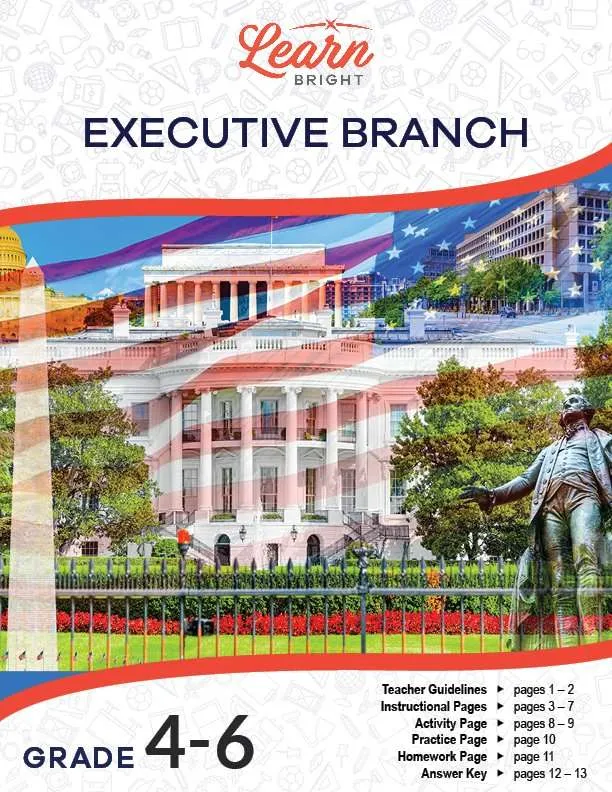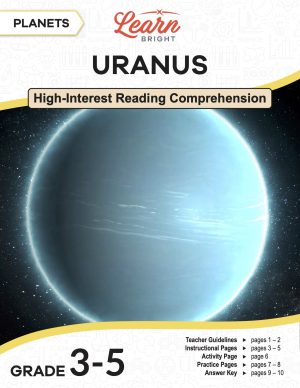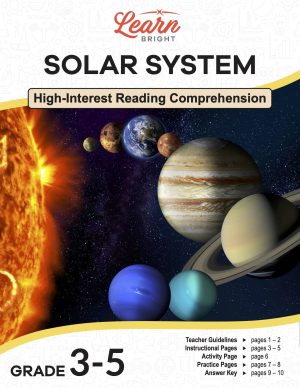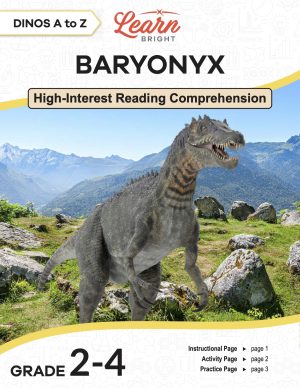Description
What our Executive Branch lesson plan includes
Lesson Objective and Overview: Executive Branch includes detailed information about the executive branch of the government in the United States. Most students may be aware of the three branches of government, which also include the judicial and legislative branches, but are often unsure of the duties of each branch. The lesson explains the responsibilities of some cabinet positions and agencies, as well as other information related to the office of the President. At the end of the lesson, students will be able to define the executive branch of the U.S. government and explain some roles and responsibilities of departments, agencies, and cabinet positions. This lesson is for students in 4th grade, 5th grade, and 6th grade.
Classroom Procedure
Every lesson plan provides you with a classroom procedure page that outlines a step-by-step guide to follow. You do not have to follow the guide exactly. The guide helps you organize the lesson and details when to hand out worksheets. It also lists information in the orange box that you might find useful. You will find the lesson objectives, state standards, and number of class sessions the lesson should take to complete in this area. In addition, it describes the supplies you will need as well as what and how you need to prepare beforehand.
Options for Lesson
Included with this lesson is an “Options for Lesson” section that lists a number of suggestions for activities to add to the lesson or substitutions for the ones already in the lesson. For an additional activity, you can assign students either a Cabinet or executive office position to research and present to the class. You can also assign members of your class to become Secretaries of Cabinet departments and tell them to try to persuade the President to increase their department’s funding. You could have your students research the current Cabinet heads and other current presidential appointees. Finally, you can use the internet or newspapers to complete an “Acronym Search” of Cabinet departments or agencies in the news.
Teacher Notes
The teacher notes page includes a paragraph with additional guidelines and things to think about as you begin to plan your lesson. This page also includes lines that you can use to add your own notes as you’re preparing for this lesson.
EXECUTIVE BRANCH LESSON PLAN CONTENT PAGES
Who is in Charge?
The Executive Branch lesson plan includes five content pages. The President of the United States is the nation’s chief executive. This is sort of like being a CEO or the head of a company. Like a CEO, the president has many people who help them carry out their responsibilities and the responsibilities of the executive branch of the government.
The Executive Branch includes the President, Vice President, the Executive Office of the President, and the Cabinet. The President has the most power in this group, but all of these roles are important. The other two branches of the government are the Judicial Branch (which includes the Supreme Court and judges) and the Legislative Branch (which includes the Senate and the House of Representatives). The citizens of the United States vote some of the people in the different branches into office while the President appoints others.
The three branches of the government must work together. While we call the President the leader of the government, we really mean that he is the leader of the Executive Branch.
The President
You must be at least 35 years old, have lived in the U.S. for at least 14 years, and be a citizen born in the United States to be president. Presidents serve no more than two terms, or eight years total.
The President leads the executive branch, the branch responsible for instituting the laws passed by the legislative branch. Many people work in the executive branch because this branch includes many different departments and agencies. The president must appoint citizens to be in charge of each executive office. These people usually agree with the president’s views and positions.
In addition to appointing these positions, the president also has many other responsibilities. The president acts as the Commander-in-Chief, which means they are in charge of the whole military. They sign and enforce, or veto, laws that the legislative branch passes. They are also in charge of diplomacy with other nations. Additionally, they meet with foreign leaders, cooperate with other countries, and help bring peace to the world as a whole. The president also signs treaties and agreements related to trade or other matters with other countries. Finally, they can grant pardons to people charged with and convicted of a federal crime.
The president also does much more than this. Some of their responsibilities are fun! They host dinners for world leaders, meet with winning sports teams, hold press conferences, deliver speeches to the nation, host special holiday events, and more.
The Vice President is also part of the executive branch. They must take over if anything happens to the president. They also break ties in the Senate and advise the president.
The Executive Office
The President appoints the members of the Executive Office of the president to help with the duties of the executive branch. There are three main categories of these people: White House Staff, the National Security Council (NSC), and the Press Secretary.
The White House staff lead the EOP (Executive Office of the President) and includes some of the president’s closest advisors, some of whom the Senate must approve. However, the President also hires some directly.
The National Security Council assists and advises the president about issues related to national security and intelligence.
The Press Secretary is part of the White House Communications team. They hold press conferences to inform the media of what the president is doing, answer questions, and keep the public informed.
The executive office are the people closest to the president. The president therefore usually appoints people who are supportive of them to these positions.
The Cabinet
The Cabinet is another big part of the Executive Branch. It includes the heads of 15 different departments in the government, each of whom the President appoints. The Senate confirms these appointments. We call each of these people the secretary of their department. For example, we call the head of the Department of the Treasury the Secretary of the Treasury. The Attorney General is the head of the Department of Justice, and is the only exception to the rule.
The lesson then lists all of the different departments and what their responsibilities are. As a whole, the Cabinet is large and has many responsibilities that they are in charge of. Most people will need to contact or work with at least one of these departments in their lifetime.
If you joined the military, you might need the Department of Veteran’s Affairs’s help to access your medical benefits. If you get a college loan, you might need to deal with the Department of Education. And if you need help with housing, you might talk to the Department of Housing and Urban Development. The Department of Education might fund your school. Each department gets money from the taxes that you and everyone else pays to fund their work.
Other agencies also enforce laws and make regulations, not just the Cabinet. FEMA (Federal Emergency Management Agency), for example, helps cities, states, and citizens recover from natural disasters like hurricanes, floods, earthquakes, or tornadoes.
The Executive Branch of the government includes the President and Vice President, but also many other people and departments who are all there to help lead the nation and its people. They must also work cooperatively with the other two branches of the government.
Sometimes, the different branches of the government might disagree with each other. When this happens, they use the system of checks and balances to make sure that one branch does not have power over the other branches.
EXECUTIVE BRANCH LESSON PLAN WORKSHEETS
The Executive Branch lesson plan includes three worksheets: an activity worksheet, a practice worksheet, and a homework assignment. You can refer to the guide on the classroom procedure page to determine when to hand out each worksheet.
CABINET ACTIVITY WORKSHEET
Students will work in groups to complete the activity worksheet. Each group will imagine that the President is putting together a new budget and needs to decide which Cabinet needs the most funding. The groups will think about each department’s responsbilities and discuss what each might need funded, using the internet to find additional information as needed. They will debate and decide on their order of importance, and will list them in order from 1 to 15. Once they’ve finished, they will share their rankings and their reasoning with the class.
Students can also work either alone or in pairs to complete the activity.
ACRONYM PRACTICE WORKSHEET
For the practice worksheet, students will first identify the meaning and/or the Cabinet department acronym, using the internet if necessary. Next, they will read different quotes and quotations, determining which cabinet secretary would have said each.
EXECUTIVE BRANCH HOMEWORK ASSIGNMENT
The homework assignment asks students to answer ten questions about the lesson material. They will then list ten roles or responsibilities of the President.
Worksheet Answer Keys
This lesson plan includes answer keys for the practice worksheet and the homework assignment. If you choose to administer the lesson pages to your students via PDF, you will need to save a new file that omits these pages. Otherwise, you can simply print out the applicable pages and keep these as reference for yourself when grading assignments.









